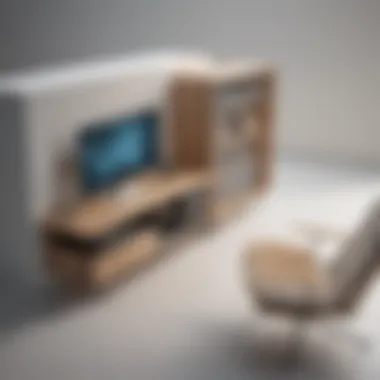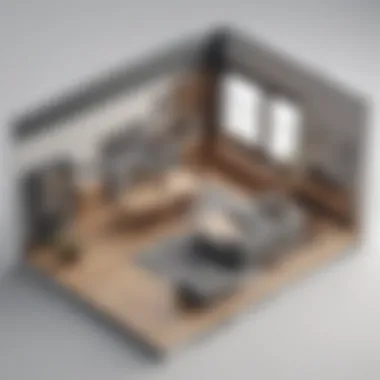Unlocking Efficiency: The Crucial Role of Furniture Plans Software in Business Success


Software Overview
As we dive into the realm of , it becomes evident that this specialized tool plays a pivotal role in enhancing operational efficiency within the furniture industry. This section will provide an insightful introduction to the software, shedding light on its key features and functionalities that cater specifically to the needs of furniture businesses. Moreover, a detailed examination of the pricing plans and available subscriptions will be conducted to assist small to medium-sized businesses in making informed decisions regarding software investment.
User Experience
User experience is paramount in the realm of technology, and so it is with . This section will meticulously evaluate the user interface and navigational elements of the software, emphasizing the importance of intuitive design in optimizing user productivity. Furthermore, the discussion will extend to the ease of use and learning curve associated with the software, ensuring that entrepreneurs and IT professionals can seamlessly incorporate it into their operations. Customer support options and reliability metrics will also be scrutinized to offer a comprehensive view of the software's user-centric approach.
Performance and Reliability
The performance and reliability of significantly impact the operational fluidity of businesses. This section will delve into the speed and efficiency of the software, analyzing its ability to handle complex furniture planning processes with precision and timeliness. Moreover, uptime and downtime statistics will be presented to demonstrate the software's reliability in meeting business demands without interruptions. The integration capabilities with other tools will also be explored, highlighting the importance of interoperability in maximizing operational efficiency.
Security and Compliance
With data security becoming a paramount concern in modern business operations, must prioritize robust security measures. This section will elucidate the data encryption and security protocols employed by the software, ensuring the protection of sensitive business information from unauthorized access. Moreover, compliance with industry regulations will be emphasized to showcase the software's commitment to maintaining legal standards in data handling. Backup and disaster recovery measures will also be discussed to underline the software's proactive approach to safeguarding critical business data.
Introduction
In the fast-paced world of furniture design and production, the role of furniture plans software cannot be overstated. This crucial tool serves as the cornerstone of efficient business operations, revolutionizing the way furniture designs are conceptualized, developed, and brought to life. By leveraging cutting-edge technology and sophisticated algorithms, furniture plans software empowers businesses to streamline their processes, enhance productivity, and stay competitive in the dynamic furniture industry landscape. As small to medium-sized businesses, entrepreneurs, and IT professionals seek to optimize their operations and drive growth, embracing furniture plans software is increasingly becoming a strategic imperative.
Understanding Furniture Plans Software
Definition and Purpose of Furniture Plans Software
At its essence, furniture plans software embodies a sophisticated digital solution that transforms design ideas into tangible furniture pieces. This software serves a dual purpose of enabling designers to create intricate 3D models and facilitating the translation of these models into comprehensive production plans. Its unparalleled precision and accuracy redefine the standards of furniture design, allowing for meticulous detailing and seamless execution. The inherent versatility of furniture plans software makes it a versatile and indispensable asset for businesses aiming to enhance their design capabilities and operational efficiency.
Evolution of Software in Furniture Design
The evolution of software in furniture design marks a paradigm shift in the industry, transcending traditional design methodologies and ushering in a new era of innovation. From rudimentary 2D drafting tools to sophisticated 3D modeling platforms, the journey of software in furniture design epitomizes the relentless pursuit of perfection and creativity. By harnessing the power of intuitive interfaces and advanced rendering techniques, modern software solutions empower designers to explore boundless creativity and bring their visionary concepts to life with unparalleled realism. This evolution underscores the transformative impact of technology on the art and science of furniture design, paving the way for limitless possibilities and unparalleled excellence.
Significance of Furniture Plans Software
Enhancing Design Efficiency
One of the primary benefits of utilizing furniture plans software lies in its capability to enhance design efficiency to unprecedented levels. By offering an extensive array of design tools and functionalities, this software equips designers with the resources needed to accelerate the design process, iterate rapidly, and visualize their ideas in breathtaking detail. The seamless integration of automation and customization features streamlines design workflows, enabling designers to focus their creative energies on innovation rather than mundane tasks.
Improving Collaboration Among Teams
In the collaborative domain of furniture design and production, effective communication and collaboration are paramount. Furniture plans software plays a pivotal role in fostering synergy among cross-functional teams, enabling seamless sharing of design files, real-time feedback, and collaborative editing capabilities. By breaking down communication barriers and enhancing team cohesion, this software cultivates a culture of collaboration, where ideas flow freely, and collective creativity flourishes.
Streamlining Production Processes
The optimization of production processes is a cornerstone of operational excellence in the furniture industry, and furniture plans software emerges as a potent catalyst in this endeavor. By providing comprehensive tools for material selection, cost estimation, and production scheduling, this software streamlines the entire production lifecycle, from design ideation to product delivery. The integration of resource planning and production management features enables businesses to minimize lead times, reduce wastage, and optimize production costs, thereby enhancing their competitive edge in the market.
Key Features to Look For
3D Visualization Capabilities


An indispensable feature of furniture plans software is its robust 3D visualization capabilities, which empower designers to create hyper-realistic renderings of their designs. This feature goes beyond traditional 2D representations, offering clients and stakeholders a captivating insight into the final product before it is even manufactured. The immersive nature of 3D visualization fosters better communication, reduces design iterations, and enhances decision-making processes, ultimately leading to superior design outcomes.
Customization Options
Customization lies at the heart of furniture plans software, enabling designers to tailor their creations to suit specific requirements and preferences. From adjusting dimensions and materials to incorporating bespoke elements, this feature empowers designers to unleash their creativity and cater to a diverse range of design needs. The flexibility offered by customization options allows businesses to differentiate their offerings, cater to niche markets, and respond swiftly to changing customer demands.
Material and Cost Estimation Tools
Precise material and cost estimation is a critical aspect of furniture design and production, ensuring optimal resource allocation and budget adherence. Furniture plans software integrates advanced tools for estimating material quantities, calculating production costs, and forecasting project timelines with unparalleled accuracy. By providing real-time insights into material usage and cost implications, this feature empowers businesses to make informed decisions, minimize financial risks, and optimize their production processes for maximum efficiency.
Benefits of Implementing Furniture Plans Software
Implementing furniture plans software plays a crucial role in enhancing business operations within the furniture industry. By embracing this technology, companies can experience a significant boost in productivity and efficiency. The utilization of such software streamlines various processes, making design tasks more manageable and collaboration among teams easier. The benefits of integrating furniture plans software extend beyond internal operations to customer satisfaction and overall business growth.
Increased Productivity
Automated Design Processes
Automated design processes are a fundamental aspect of furniture plans software that revolutionize the traditional design approach. By automating routine design tasks and calculations, this feature saves valuable time for designers and helps expedite the overall design process. The key characteristic of automated design processes is their ability to generate precise and complex designs swiftly, improving productivity and design accuracy. This makes them a favored choice for companies seeking efficient design solutions. While the advantage of automated design processes lies in their time-saving nature and error-reducing capabilities, potential disadvantages may include the need for initial setup and customization.
Real-Time Collaboration
Real-time collaboration features within furniture plans software facilitate seamless communication and coordination among team members. This functionality enables instant feedback exchange, reduces the need for prolonged email threads, and fosters a collaborative work environment. The key characteristic of real-time collaboration tools is their ability to sync design changes instantaneously, allowing team members to work simultaneously on different aspects of a project. This feature is highly beneficial for enhancing team efficiency and promoting real-time decision-making. However, challenges such as data security and coordination among team members remotely could be considered as potential disadvantages.
Cost Savings
Material Optimization
Material optimization tools embedded in furniture plans software help businesses maximize resource utilization and minimize wastage. These tools analyze design specifications and recommend optimal material quantities, aiding companies in reducing material costs and optimizing inventory management. The key characteristic of material optimization tools is their ability to provide data-driven insights that enhance decision-making regarding material selection and procurement. This feature is popular among businesses aiming to achieve cost efficiencies and sustainable practices. While the advantage of material optimization lies in its cost-saving potential and environmental benefits, challenges such as accurate data input and initial setup complexities may be considered as potential disadvantages.
Reduction in Production Errors
Reduction in production errors is a pivotal aspect of furniture plans software that contributes to cost savings and operational efficiency. By identifying and rectifying design discrepancies in real-time, this feature minimizes rework and material wastage, leading to significant cost reductions. The key characteristic of error reduction tools is their ability to conduct automated checks and simulations to pinpoint potential errors before production begins. This proactive approach helps companies maintain high-quality standards and meet delivery timelines more effectively. While the advantage of production error reduction tools lies in their cost-saving potential and quality enhancement, challenges such as software compatibility and staff training requirements could pose as potential disadvantages.
Enhanced Customer Experience
Tailored Design Solutions
Tailored design solutions offered by furniture plans software allow businesses to cater to individual customer preferences and requirements. By customizing designs according to client specifications, companies can enhance customer satisfaction and loyalty. The key characteristic of tailored design solutions is their capacity to deliver personalized furniture solutions that align with customers' unique needs. This feature is popular among businesses aiming to differentiate themselves in the market and build strong customer relationships. While the advantage of tailored design solutions lies in their ability to meet individual customer demands and preferences, challenges such as design complexity and production time constraints may pose as potential disadvantages.
Improved Delivery Timelines
Improved delivery timelines facilitated by furniture plans software enable businesses to optimize production schedules and meet customer deadlines effectively. By streamlining production processes and ensuring efficient workflow management, companies can reduce lead times and improve overall delivery performance. The key characteristic of improved delivery timelines is their ability to track order progress and production milestones, allowing businesses to proactively manage delivery expectations. This feature is beneficial for enhancing customer satisfaction and fostering long-term loyalty. While the advantage of improved delivery timelines lies in their ability to enhance operational efficiency and customer experience, challenges such as production capacity limitations and supply chain disruptions may be considered as potential disadvantages.
Selecting the Right Furniture Plans Software
Selecting the right furniture plans software is a critical decision for businesses in the furniture industry. The software you choose can significantly impact your design efficiency, collaboration among teams, and streamline production processes. To ensure optimal performance, several key elements must be considered when selecting the right software.


Considerations for Choosing Software
Scalability and Flexibility
Scalability and flexibility are paramount when selecting furniture plans software. The ability of the software to scale according to your business's needs and accommodate future growth is essential. Flexible software allows for customized solutions that align with your specific requirements. This characteristic ensures that the software can adapt to changes in the market and industry dynamics. Although scalability and flexibility may require a higher initial investment, the long-term benefits in improved productivity and performance outweigh the costs.
Integration with Existing Systems
Integration with existing systems is crucial for seamless workflow and data management. The software should be compatible with your current infrastructure to enable smooth data transfer and communication between different departments. A well-integrated system enhances collaboration and efficiency across teams, reducing errors and redundancies. Choosing software that can easily integrate with other tools and platforms in your organization ensures a cohesive technological environment and maximizes the software's utility.
User-Friendly Interface
A user-friendly interface is essential for user adoption and productivity. Intuitive software with a simple interface enhances usability and reduces the learning curve for employees. An easy-to-navigate system improves efficiency as users can quickly access tools and features, thereby accelerating project timelines. Training costs are minimized, and the likelihood of errors decreases with a user-friendly interface. Prioritizing software with a user-centric design ensures that employees can utilize the software effectively, leading to increased overall performance.
Popular Software Solutions
AutoCAD
Auto CAD is a versatile software widely used in furniture design for its robust design tools and 3D modeling capabilities. Its key characteristic lies in its precision and accuracy, allowing designers to create detailed furniture plans with ease. AutoCAD's unique feature of parametric modeling enables users to make quick modifications to designs, facilitating an agile design process. While AutoCAD's advanced functionalities make it a preferred choice for complex projects, its complexity may require extensive training for new users.
SketchUp
Sketch Up is renowned for its user-friendly interface and intuitive design tools, making it a popular choice for furniture designers. The key characteristic of SketchUp is its simplicity, enabling users to create intricate 3D models efficiently. Its unique feature of a vast library of extensions provides additional functionalities for specialized design requirements. While SketchUp is ideal for small to medium-sized businesses due to its affordability and accessibility, it may lack the advanced capabilities required for complex projects.
SolidWorks
Solid Works is favored for its parametric modeling abilities and comprehensive design functionalities. Its key characteristic lies in its integration of mechanical design with furniture modeling, catering to intricate and technical projects. The unique feature of SolidWorks being part of the Dassault Systèmes ecosystem allows for seamless collaboration across various design disciplines. While SolidWorks is a top choice for large businesses with complex design needs, its cost and learning curve may pose challenges for smaller enterprises.
Implementing Furniture Plans Software Effectively
Implementing furniture plans software effectively is a crucial aspect in the realm of successful business operations within the furniture industry. It plays a pivotal role in enhancing design processes, optimizing production workflows, and ensuring seamless collaboration among teams. By effectively implementing this software, businesses can experience heightened efficiency, accuracy, and innovation in their operations.
To ensure the optimal utilization of furniture plans software, it is essential to prioritize thorough training and onboarding for all staff members. Staff training programs should be tailored to equip employees with the necessary skills and knowledge to leverage the software effectively. These programs empower individuals to navigate the tools, features, and functionalities of the software proficiently, thereby maximizing its potential benefits.
Integration support stands out as another critical element in effectively implementing furniture plans software. This feature enables seamless integration of the software with existing systems and tools within the organization. By ensuring compatibility and synergy between different platforms, integration support fosters cohesive workflows and data exchange, thereby enhancing overall operational efficiency.
Training and Onboarding
Staff Training Programs
Staff training programs hold significant importance in the successful implementation of furniture plans software. These programs are designed to educate employees on the utilization of the software's features and tools, enhancing their proficiency and productivity levels. By investing in comprehensive staff training programs, businesses can empower their workforce to leverage the software effectively, leading to improved design processes and streamlined operations.
Key characteristics of staff training programs include personalized learning modules, hands-on practical exercises, and continuous performance evaluations. These programs are a popular choice for organizations aiming to enhance their employees' skill sets and adaptability to technological advancements in the furniture industry.
The unique feature of staff training programs lies in their tailored approach to meet the specific needs and competencies of each employee. By addressing individual learning curves and preferences, these programs ensure that all staff members can efficiently navigate the software and capitalize on its functionalities.
Integration Support


Effective integration support is crucial for seamlessly incorporating furniture plans software into existing organizational frameworks. This feature facilitates the smooth transfer of data, processes, and information between different systems, ensuring a cohesive and integrated operational environment. Integration support plays a vital role in eliminating silos, enhancing communication channels, and optimizing resource utilization.
Key characteristics of integration support include system compatibility assessments, data migration strategies, and custom integration solutions. This feature is a popular choice for organizations seeking to streamline their business processes and maximize the value of their software investments.
The unique feature of integration support lies in its ability to unify disparate systems and technologies within a single interface. By providing a consolidated platform for data exchange and workflow integration, integration support simplifies complex processes and promotes synergy across different departments.
Monitoring Performance Metrics
Design Efficiency
Design efficiency is a critical element in evaluating the effectiveness of furniture plans software in enhancing business operations. This aspect focuses on the software's ability to streamline design processes, optimize resource allocation, and minimize errors in the design phase. Design efficiency plays a key role in accelerating product development cycles and ensuring high-quality output.
Key characteristics of design efficiency include automated design tools, real-time collaboration features, and advanced visualization capabilities. This aspect is a beneficial choice for organizations looking to improve their design workflows and deliver innovative solutions to clients.
The unique feature of design efficiency lies in its capacity to enhance creativity, accuracy, and speed in the design process. By automating repetitive tasks, facilitating team collaboration, and providing visualization tools, design efficiency empowers businesses to create compelling and functional furniture designs efficiently.
Production Timelines
Monitoring production timelines is essential for assessing the impact of furniture plans software on operational efficiency. This aspect involves tracking the time taken to complete various production stages, identify bottlenecks, and optimize workflow sequences. By monitoring production timelines, businesses can improve resource allocation, reduce lead times, and enhance overall productivity.
Key characteristics of production timelines include milestone tracking, workflow automation, and production analytics tools. This aspect is a popular choice for organizations seeking to streamline their manufacturing processes and meet customer demand effectively.
The unique feature of production timelines lies in its ability to provide real-time insights into production processes, identify inefficiencies, and implement corrective measures promptly. By enforcing time-bound targets and monitoring progress, production timelines enable businesses to achieve operational excellence and meet project deadlines efficiently.
Continuous Improvement Strategies
Feedback Mechanisms
Feedback mechanisms play a pivotal role in facilitating continuous improvement in furniture plans software utilization. These mechanisms are designed to gather user feedback, evaluate software performance, and implement enhancements based on user insights. By collecting and analyzing feedback, businesses can iterate on their software solutions, address user concerns, and drive innovation in their operations.
Key characteristics of feedback mechanisms include user surveys, performance evaluations, and feedback analysis tools. This aspect is a beneficial choice for organizations committed to enhancing the usability, functionality, and value proposition of their software products.
The unique feature of feedback mechanisms lies in their ability to foster a culture of transparency, responsiveness, and customer-centricity within the organization. By actively engaging users, collecting feedback, and implementing iterative improvements, feedback mechanisms enable businesses to deliver customer-centric software solutions that meet evolving market demands.
Software Updates
Regular software updates are essential for ensuring the relevance and effectiveness of furniture plans software in the ever-evolving business landscape. These updates involve incorporating new features, addressing security vulnerabilities, and enhancing overall software performance. By staying current with software updates, businesses can maximize the benefits of their investment, remain competitive, and adapt to industry trends.
Key characteristics of software updates include version control, feature enhancements, and bug fixes. This aspect is a popular choice for organizations looking to stay ahead of the curve, leverage the latest technologies, and maintain a competitive edge in the furniture industry.
The unique feature of software updates lies in their ability to address user feedback, introduce innovative functionalities, and ensure software compatibility with external systems. By embracing regular updates, businesses can harness the full potential of furniture plans software, drive operational efficiency, and foster continuous improvement in their operations.
Conclusion
In the realm of successful business operations, the importance of leveraging furniture plans software cannot be overstated. This pivotal aspect of modern enterprises plays a crucial role in enhancing design efficiency, promoting collaboration among teams, and streamlining production processes. By incorporating furniture plans software into daily operations, businesses in the furniture industry can achieve greater precision, productivity, and competitiveness. The utilization of advanced tools and technologies offered by such software empowers organizations to meet the evolving demands of the market and stay ahead of the curve.
Maximizing Business Potential
Embracing Technological Advancements
Delving into the realm of technological advancements within the furniture industry unveils a wealth of opportunities for businesses seeking to optimize their operations. By embracing cutting-edge software solutions tailored for furniture design, companies can revolutionize their approach to product development and manufacturing processes. The key characteristic of embracing technological advancements lies in the seamless integration of advanced features such as 3D visualization capabilities, customization options, and precise material and cost estimation tools. These unique features not only streamline design workflows but also enhance the accuracy and speed of production, ultimately leading to improved efficiency and quality outcomes for businesses implementing such innovations.
Adapting to Industry Trends
In the fast-paced landscape of the furniture industry, adapting to current industry trends is imperative for businesses aspiring to maintain relevance and meet consumer demands. The key characteristic of adapting to industry trends lies in the agility and foresight to align business strategies with emerging market preferences and technological advancements. By staying attuned to changing consumer preferences, sustainable materials, and innovative design concepts, companies can position themselves as key players in a competitive environment. While challenges may arise in adapting to evolving trends, the advantages are manifold, including improved customer satisfaction, brand reputation, and market positioning.







